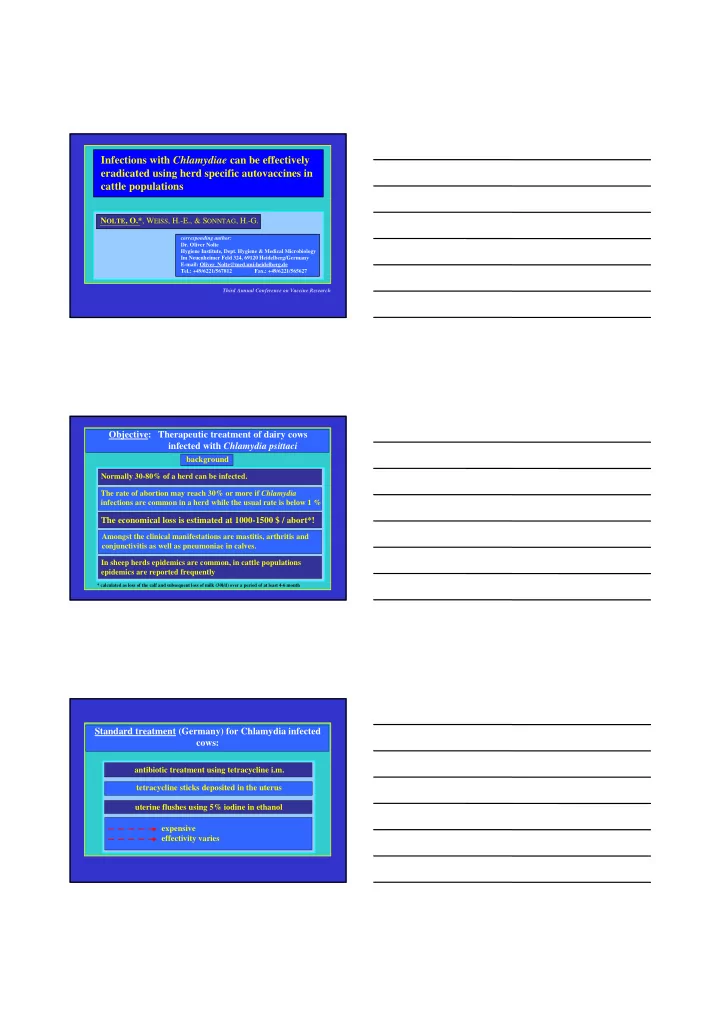

Infections with Chlamydiae can be effectively eradicated using herd specific autovaccines in cattle populations N OLTE , O.* , W EISS , H.-E., & S ONNTAG , H.-G. corresponding author: Dr. Oliver Nolte Hygiene Institute, Dept. Hygiene & Medical Microbiology Im Neuenheimer Feld 324, 69120 Heidelberg/Germany E-mail: Oliver_Nolte@med.uni-heidelberg.de Tel.: +49/6221/567812 Fax.: +49/6221/565627 Third Annual Conference on Vaccine Research Objective: Therapeutic treatment of dairy cows infected with Chlamydia psittaci background Normally 30-80% of a herd can be infected. The rate of abortion may reach 30% or more if Chlamydia infections are common in a herd while the usual rate is below 1 % The economical loss is estimated at 1000-1500 $ / abort*! Amongst the clinical manifestations are mastitis, arthritis and conjunctivitis as well as pneumoniae in calves. In sheep herds epidemics are common, in cattle populations epidemics are reported frequently * calculated as loss of the calf and subsequent loss of milk (30l/d) over a period of at least 4-6 month Standard treatment (Germany) for Chlamydia infected cows: antibiotic treatment using tetracycline i.m. tetracycline sticks deposited in the uterus uterine flushes using 5% iodine in ethanol expensive effectivity varies
Definition: autovaccine or autogenous vaccine therapeutic vaccine manufactured from a disease causing pathogenic micro-organism — strain and patient specific in veterinary medicine often herd or flock specific therapeutic — treatment of ongoing infections immunogenic (?) — modulation of the patients immune system. intended to stimulate the immune system, not to hit the micro- organism directly—therefore no development of resistance highly specific, independent of antigenic variability cheap to manufacture no governmental approval required overall amount of dairy cows autovaccinated to treat overall amount of dairy cows autovaccinated to treat chlamydial infections chlamydial infections 8 veterinarians involved 30 herds were treated ap. 2500 individuals autovaccinated route of application route of application intravaginal subcutaneous intranasal autovaccine placebo Chlamydia 2 2 negative* Chlamydia 19 5 9 11 positive* * as determined using Stamp staining Σ =48 (out of five different herds)
Method: Autovaccines were prepared* from index case (i.e. abortion caused by Chlamydia spec. ). procedure cervical swabs ( obtained from herds in which the index case was recorded ) were screened by Stamp staining of inclusion bodies herds were treated with the herd specific autovaccine four times (one dose on every 5 th day). Randomly chosen Chlamydia positive cows were examined in detail cervical swabs were taken from the chosen cows after completion of autovaccination (i.e., day 28 after 1 st dose of autovaccine) to check for the presence of Chlamydiae * patent pending DE/PCT/EP Stamp staining routine screening method in veterinary diagnostics* to check for the presence of Chlamydiae (cervical) swabs are smeared on slides and subsequently stained using carbolfuchsin (Ziehl`s stain)—1% acetic acid—0.2% Malachite Green. both forms of the Chlamydia are stained intensively red whereas the background is in light green. Stamp staining is also good for staining of Coxiella and Brucella , these micro-organisms differ in their morphology and appearance * one of the methods recommended by the Bundesministerium für Ernährung, Landwirtschaft und Forsten [Ministry of food, agriculture and forestry] (order BGBl. I S. 1178; September 1999) Outline autovaccination uterine swabs (cervix) & Stamp staining Chlamydia positive* 1 week Diagrammatic representation of disease state, immunisation schedule and sampling of blood. ( ) denotes subcutaneous/intranasal or intravaginal immunisation, ( ) and denotes blood/serum sample * often suffering from metritis and/or reduced fertility
Results (28 days after start of autovaccination) Results (28 days after start of autovaccination) intravaginal subcutaneous intranasal autovaccine placebo 1 Chlamydia 2 2 2 negative* 1 2 1 2 Chlamydia 19 5 9 5 11 17 positive* 8 9 Σ =48 (out of five different herds) 2 2 * as determined using Stamp staining 5 groups of animals Σ =48 Chlamydia positive 41 negative after av: 36 =87.8% autovaccine: Chlamydia positive 5 negative after pl: 5 placebo: Chlamydia negative 2 negative after av: 1 autovaccine: Chlamydia negative 2 negative after pl: 0 placebo: Results: Serum antibodies against Chlamydia psittaci antigen in micro complement binding assay antibody titer in micro-CBA mean antibody titer +S.E. 40 20 P <0.05 0 subcutan (n=19)* intranasal (n=11)** intravaginal (n=9)** day 0 day 7 positive control 1:40 day 28 negative control <1:10 * belonging to 3 different herds ** belonging to 2 different herds
Conclusions: Autovaccines seems to be a useful and effective method for the treatment of Chlamydia infection. More than 87% of autovaccinated cows were Chlamydia negative afterwards. The veterinarians reported decline to normal abortion rate and normal metritis/abortion incidence in herds treated with the autovaccine. However, the immunological background remains unknown. Autovaccines are cheap to manufacture and can be given even to pregnant cows. The observed side effects were minor, only after intravaginal application cows showed an increased sensitivity. No serious side effects were observed.
Recommend
More recommend